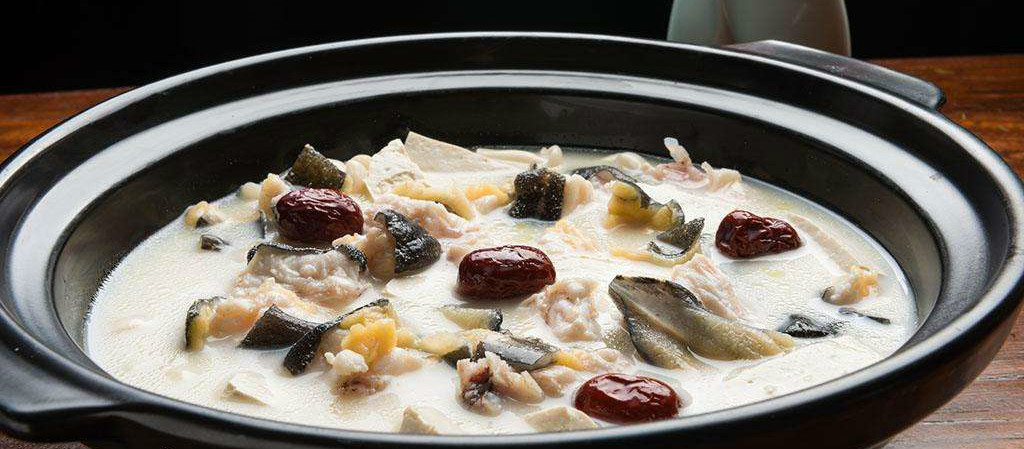008613762194311 | 008613762194311 tour-zhangjiajie@outlook.com
008613762194311 | 008613762194311 tour-zhangjiajie@outlook.com
1, Famous dish - Baby Fish
' Baby Fish'(scientific name is Giant Salamader)is one of Zhangjiajie's special produce, it is also a famous dish in other parts of China, The traditional eating method is: to get rid of the phlegm, split its body and remove the waste, then cut into strips and finally wash. Use vegetable oil to fry then put a slice of ginger, shallot, salt and sauce into accentuate the taste - this cooking style is called " Xiao Chao Huang Men". Another way to cook it is to use the steamed casserole technique. Both ways are permissible, therefore it is simply a case of preference or pot luck with both cutcomes pleasing to the taste buds. This dish is not only delicious, but also very nutritious. The baby fish is classed as a second class nationally protected animal, so even though it is yummy, you are not however allowed to catch and kill this type of fish. Good news is that Zhangjiajie has artificially farmed fish on their menu. Say after me in Chinese - 'Duo Chi Yi Dian' - please eat some more.

2, Stewed Dog Meat with Casserole
"Stewed Dog Meat with Casserole" is a traditional dish of the Tujia People. The cooking method is rather complicated; first, you must cut 1.5kg of dog meat with its skin intact into three big pieces, wash the pieces and place them into the pot, then use a large flame to boil the water. When the water is boiling, take the dog meat out of the pot, clean once again. After this, put all of the ingredients into the casserole along with clean water( add the water to cover the meat),then put all the seasonings such as ginger, shallot and alcohol together, cover it and use the big flame to boil the water, the turn the flame smaller, simmer for around 10 to 15 mins and then take it out of the water, get rid of the bones and put the bones into soup. Meanwhile, cut the dog meat into pieces of 1 inch long and 3 fens thick. Afterwards, put the dog meat into oily pot to fry, add s clash of alcohol when frying it and then transfer the fried meat into the casserole, using the bone soup to cook, meanwhile, put some salt, pepper, sliced ginger and cinnamon into steam for half an hour. The last ingredients required are some salt, pepper and chopped shallot, this delicious dish is at last prepared and definitely ready to savor!
3,Hao'zi Ba'ba
In the Tujia Miao area, they have a special custom which is called" On the Third of March, use Hao'zi Ba'ba to prick the eyes of a snake", what on earth can this mean? Well, every year on the third of March according to the lunar calendar, every household must eat Hao'zi Ba'ba, which symbolizes that a household has used the Hao'zi Ba'ba to cover the snake's eyes and as a relust, the snake are then unable to surface from their holes to hurt people.
in March, when the temperature is rising, after coming out of hibernation, the snakes begin to work their wicked ways. It is said that if you use Kobresia herbs, dip into water and then dehydrate it, at last spread them across a table and marvel at step one of this superb recipe. Then mix with the sticky rice powder to make Ba'ba for the God, proceed to ask the God to help block the snakes in their hole to avoid them srufacing to afflict the innocent villagers. This old custom has been carried out continentally for two thousand years, and doesn't show any sign of dwinding as it is very popular in the west Hunan region. Of course, with the spread of education, culture and science, Hao'zi Ba'ba made today can and are usually treated as a dish, and not necessarily as a superstition offering to God.
The method of making and eating Hao'zi Ba'ba is as follow: pick the tender Hao'zi leaves. Its popular name is" Ba'ba Song", green in color, with a white fine hair at the bottom. After taking them back, pound them and then dip into water, dehydrate, and then spread once again across a table. Next, you should mix this with the sticky rice powder to make Yuan Ba'ba. In the middle section of Ba'ba preserved ham is a must, vegetables and finally shallot. At times you may also find the Ba'ba to be hollow inside i.e. there is no perserved ham present. The Ba'ba can be eaten either hot or cold and choice is completely up to the consumer. Hao'zi Ba'ba can also be barcecued or re-steamed with the end result always the same in the taste department - very scruptious, an undoubtedly specail kind of local cuisine.
4, Ga Ga Chicken
Ga Ga Chicken's other name is Yan Ji, and belongs to the aves phasianidae family. it is famous for making what can only be described as a ' Ga Ga' sound. Ga Ga chicken usually live in mountainous areas, flying with the clumsiest of movements, with the stipulation that the sky had darkened or when there is a sudden change in the weather. Where cows are notorious for lying down before the onset of rain, these chickens will suddenly ' Ga Ga' to forecas the weather.
Ga Ga Chicken is relatively fatter than their familia counterparts i.e. the chickens you find in your local supermarket, usually weighting between 1.5kg and 2.5 kg, some big ones can weight as much as 3.5kg - 4.5kg. The Ga Ga Chicken's meat is very succulent, delicious and nutritious; however it doese smell blander than the raised family chicken. A great suggestion is to try eating this dish with wine and it should be borne in mind that this is one of the most famous wild bird and animal meat delicacies.

5,Shang Cangzi Oil
Shang Cangzi ( the local people call it " Spicy Jiangzi" or " Mountain Pepper"), is a pleasant side dish option to accompany most of the food on offer.
Shang Cangzi is best served fresh, and can also be used as a base to cook other dishes, if you so desire. The main constituents of the oil are Limonene and Formaldhyde Heptenone. It can be used to make up different kinds of food, and can be used to make cigarettes, make-up, toothpaste and in the perfuming of soap or shower gel. Moreover, it is the best raw material of the ionone compound ( flavoring ingredient which is used to synthesize vitamin A). It is worth mentioning that no matter whether you intent on eating dumplings, rice noodle or common noodles, you just need to add one drop of this oil to allow the food to be at its most appetizing. When requiring a more spicy taste and especially if you eat fish, Eel and/or Loach, drip one or two drops into the dish and its special fragrance will fill you with delight.
6,Loach with Bean curd
Certainly one of the most popular. Tujia foods! First, you have to put to the small loach into a crock or a jay, pour in some water and add a bit salt to promote and combine the taste. Feed the loach over night with the purpose of cleaning its inner body. Then, use the clean water to wash it and place the ( live) Loach into the soft bean curd, let it swim inside the Dou Fu until lots of holes begin to appear. Then put the whole bean curd and loach into the hot oil, add the chopped green onion, MSG, chopped ginger and last of all, the glorious sauce. This dish is very nutritious; the texture is soft and smooth and is a suitable dish to serve to any member of the family.
7,Tujia Three Cooks
Just mention the story of the Three Cooks and every person on their voyage to Zhangjiajie will know it inside out. It is said that in the year of Jia Jin Emperor's reign during the Ming Dynasty, the government called up the Tusi from west Hunan and Hubei to fight the armies who were battling with the Japanese military. However, because it was in the midst of the spring festival the Emperor ruled that the military plan must not be delayed. The Tusi King then proclaimed that the spring festival should be celebrated one day in advance. Preserved pork, Bean curd and Turnip were all mixed together to cook what is called " He Cai", the translation of which is aptly" Mixed Food". The name Three Cooks came about in more recent times which are used to allde to the Emperor, King and the People colluding to defeat the axis of evil.
8, South China Amolops
South China Amolops, also goes by the name of Rana Spinosa, is called ' Bang Bang' by the local people. It belongs to the amphibian ranid family, an expert at catching the water snake. South China Amolops usually lives amongst the stones found at brooks and rivers; they meet during the evening to bond with one another. It mates with the Ban fish to produce offspring. No matter daytime, the South China Amolops always makes it quintessentail croaking sound ' Bang Bang', so it has consequently taken on the nickname ' Bang Bang'. South China Amolops meat is very succulent, especially when steamed in a soup, and challenges the reputation of chicken soup as the most consistently tasty soup ( at least were the villages are concerned). Besides this, it is also very nutritious and is farmed for being an extremely expensive dish. All in all, this is the choice dish for the distinguish guest, why not treat yourself to this enticing dish?
Previous Page:The World's No.1 Things in Zhangjiajie
Next Page:6 Unknown Riddles of Tianmen Mountain